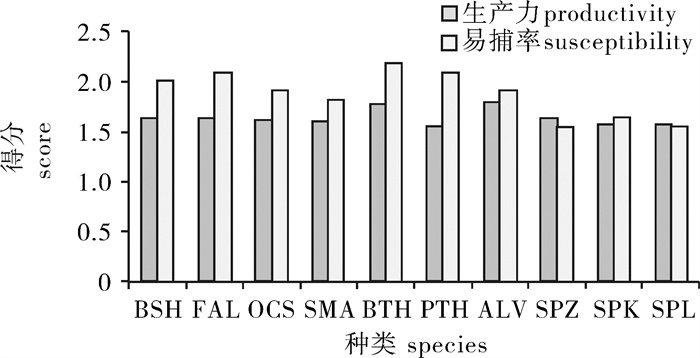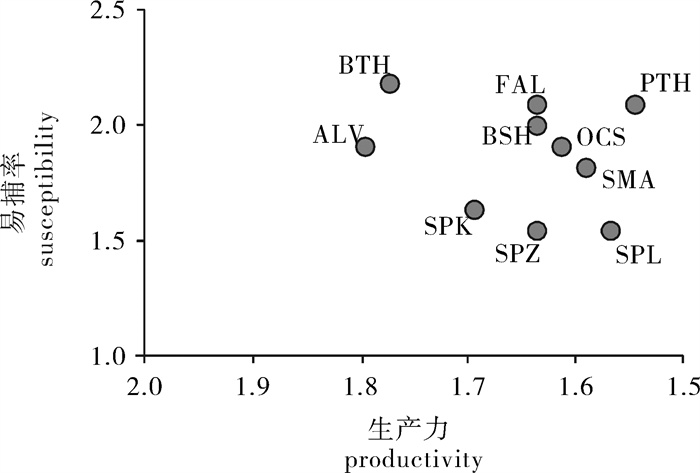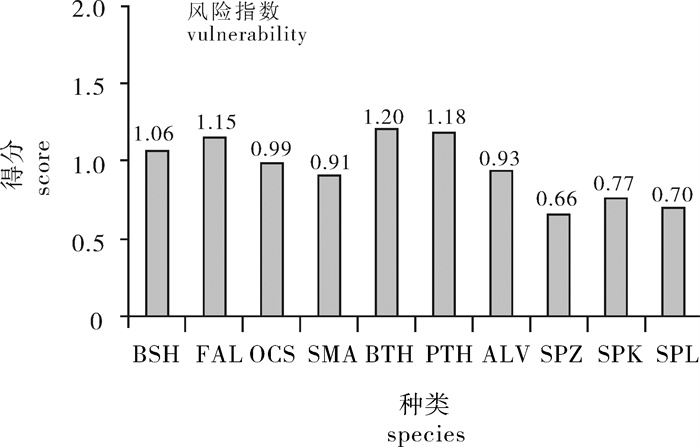Productivity-susceptibility analysis of 10 shark populations in tropical Pacific Ocean
-
摘要:
热带太平洋是全球产量最高的金枪鱼渔场, 大洋性鲨鱼种群遭受金枪鱼渔业的影响受到国际社会的高度关注。由于缺少渔业统计资料, 一般难以运用标准的资源评估方法对这些兼捕的种类进行评估。笔者运用种群生产力-易捕率分析(productivity-susceptibility analysis, PSA)方法, 对热带太平洋10种鲨鱼遭受金枪鱼延绳钓渔业影响的风险程度进行比较分析, 并计算风险指数(vulnerability)。风险指数从低到高的种类依次为锤头双髻鲨(Sphyrna zygaena)、路氏双髻鲨(S.lewini)、无沟双髻鲨(S.mokarran)、尖吻鲭鲨(Isurus oxyrinchus)、狐形长尾鲨(Alopias vulpinus)、长鳍真鲨(Carcharhinus longimanus)、大青鲨(Prionace glauca)、镰状真鲨(C.falciformis)、浅海长尾鲨(A.pelagicus)、大眼长尾鲨(A.superciliosus), 表明大眼长尾鲨种群受延绳钓渔业影响而遭受过度捕捞的潜在风险最高, 垂头双髻鲨的风险最低。该研究结果可以为热带太平洋金枪鱼延绳钓渔业的管理和生态系统保护提供科学参考。
Abstract:The tropical Pacific Ocean is the main tuna fishing area in the world. The impact of tuna longline fishery on pelagic shark populations has received considerable concerns recently. However, it is difficult to evaluate their population status using formal stock assessment models due to the lack of long-term fishery data. We conduct productivity-susceptibility analysis (PSA) to evaluate the vulnerability to overfishing for 10 pelagic shark species in the tropical Pacific Ocean. The 10 species with risk of overfishing suffered from longline fishery, in terms of vulnerability score, are as follows (in ascending order): smooth hammerhead (Sphyrna zygaena), scalloped hammerhead (S.lewini), great hammerhead (S.mokarran), shortfin mako (Isurus oxyrinchus), common thresher (Alopias vulpinus), oceanic whitetip shark (Carcharhinus longimanus), blue shark (Prionace glauca), silky shark (C.falciformis), pelagic thresher (A.pelagicus) and bigeye thresher (A.superciliosus). The results provide important information for conservation of pelagic sharks and pelagic ecosystem interacting with tuna longline fisheries in the tropical Pacific Ocean.
-
Keywords:
- shark /
- vulnerability /
- overfishing /
- longline /
- Pacific Ocean
-
20世纪80年代开始,澳大利亚、美国、英国、丹麦等国对食品微生物生长、失活、残存和风险评估模型进行了广泛研究[1-3],目的是使用微生物预测模型描述不同物理和化学条件下微生物变化情况,客观评价食品在加工、流通、销售、贮藏过程中各种影响因子对食品安全和品质的影响,运用数学模型对微生物的动态变化进行快速有效预测和评价。近年来,美国、英国、丹麦等国致力于构建微生物特征数据库,开发了Food Micromodel, Pathogen Modeling Program, Seafood Safety and Spoilage Predictor等专家系统,用于食品品质预测和安全评估,实现关键控制点分析,协作管理者进行管理。
食品微生物生长模型通常有Monod, Gompertz, Baranyi, Logistic等模型,其中修正的Logistic和Gompertz模型被广泛采用。Baranyi和Robert[4]综合Logistic模型和Michaeli-Menton模型开发了Baranyi模型,该模型相对来说比较复杂。本研究中养殖大黄鱼(Pseudosciaena crocea)取自福建闽东三都湾养殖区(26°35′~26°55′N),2005年3月海水温度变化幅度为10.5~11.1℃。依据以前对0、5℃恒温冷藏过程中采用感官、挥发性盐基氮(TVBN)、菌落总数(TVC)进行品质变化研究的基础上,本文采用修正的Logistic和Gompertz模型拟合细菌生长曲线,经非线性回归分析,求出预测模型的动力学参数,建立了细菌生长预测模型,并对2种模型的适用性进行了分析。
1. 材料与方法
1.1 试验材料
大黄鱼在福建省闽东三都湾养殖场捕获(2005年3月),立即放入冰水中冷休克。选用大小基本一致的个体(300~400 g·尾-1)。
1.2 贮藏实验
到达实验室后,将鱼腹部朝上装入下有篦子能沥水的塑料盆中,盖上有漏气孔的盖,分别放入高精度低温培养箱(Sanyo MIR 153, 日本)中,控制贮藏温度在0、5±0.1℃。每隔适当时间取出试样鱼进行感官鲜度评价、TVBN、TVC测定,综合确定产品货架期,本次研究未给出和分析感官、TVBN实验数据。
1.3 样品处理
随机抽取2尾试样鱼,先进行生鱼感官评价,然后去鳞去内脏去腮洗净,用干净吸纸擦干。沿脊骨剖切,取半条鱼肉(带鱼皮),用组织捣碎机打碎,用于TVBN和TVC测定;其余半条鱼蒸熟后用于感官评价。
1.4 感官鲜度评价
由6名经过训练的评价员组成感官评价小组,评价生鱼的气味和蒸熟后鱼的气味和味道。采用3分法进行评分,0为最好品质,1为鲜鱼的鲜香味消失,0~1为高品质期,2为明显出现臭味和异味即可接受界限[5]。当半数或以上评价员评价2或以上时,即为货架期终点(感官拒绝点)。
蒸熟时将带头的半条鱼分别用铝箔包好,待锅中水沸腾后,放入锅内的金属篦子上,盖上锅盖蒸20 min,打开锅盖后立即进行感官评价。
1.5 菌落总数计数
称取鱼肉浆10.0 g,加入90 mL 0.1%蛋白胨无菌生理盐水,高速振荡后,以10倍稀释将鱼肉浆稀释,取3个浓度合适的稀释液0.1 mL,涂布于标准琼胶培养基(中国科学院上海昆虫科技开发公司康乐培养基有限公司)平板表面。每个稀释液涂布2个平皿,25℃培养48 h。
1.6 细菌生长曲线拟合
0、5℃大黄鱼贮藏实验得到的细菌增殖动态数据,采用修正的Gompertz方程和Logistic方程[6]描述其生长动态。修正Gompertz方程如下:
$$ \lg N(t)=A+C \times \exp \{-\exp [-B \times(t-M)]\} $$ (1) 式中t为时间(h),N(t)为t时的菌数(lgCFU·g-1),A为初始菌数N0(lgCFU·g-1),C为最大菌数Nmax与N0之差(lgCFU·g-1),M为1/2Nmax时的时间(h),B为M时比生长速率(h-1),最大比生长速率μmax=BC/e。
修正Logistic方程如下:
$$ \lg N(t)=A+C / \exp \{1+[-B \times(t-M)]\} $$ (2) 式中t为时间(h),N(t)为t时的菌数(lgCFU·g-1),A为最小菌数N0(lgCFU·g-1),C为最大菌数Nmax与N0之差(lgCFU·g-1),B为最大比生长速率μmax (h-1),M为1/2Nmax时的时间(h)。
实验数据用Statistica (Release 5.5)统计软件采用最小平方差法进行非线性回归。
1.7 细菌生长模型的可靠性评价
细菌生长动力学模型求得的预测值,与大黄鱼贮藏实验所得的细菌生长的实测值比较,依据均方根[7]评价建立的生长动力学预测模型的可靠性。均方根用下式表示:
$$ \text { RMS }=\left[\frac{\sum_i\left(\lg N_{i, \text { predicted }}-\lg N_{i, \text { obsered }}\right)^2}{n}\right]^{0.5} $$ (3) 式中lgNi, predicted为冷藏实验中菌落总数预测值(lgCFU·g-1),lgNi, observed为菌落总数实测值(lgCFU·g-1),n为测试次数。
2. 结果
2.1 0℃冷藏大黄鱼细菌生长模型
0℃冷藏期间菌落总数实测值和预测值见表 1。开始贮藏4~5 d,细菌生长缓慢,菌落总数小于6.0 lgCFU·g-1,这是由于暖带海域水温高于温带海域,中温菌数量多, 冷藏过程不耐低温,生长受到抑制,甚至死亡。同时一些嗜冷菌逐渐适应低温环境,随着贮藏期的延长,细菌生长加快,进入指数生长期,好冷菌增殖速度逐渐达到高峰,细菌数呈几何级数增加,腐败终点依据感官评分、TVBN、TVC(7.31 lgCFU·g-1)确定产品货架期为409 h。
表 1 0℃冷藏大黄鱼菌落总数Table 1 Total viable counts of P.crocea stored aerobically at 0℃lgCFU·g-1 时间/h
time实测值
observed valuesGompertz预测模型predictive model Logistic预测模型predictive model 预测值
predicted values残存值
residual values预测值
predicted values残存值
residual values0 5.20 5.20 0.00 5.21 -0.01 49 5.10 5.20 -0.10 5.24 -0.14 76 5.25 5.21 0.04 5.29 -0.04 123.5 5.34 5.42 -0.08 5.48 -0.14 167 6.05 5.95 0.10 5.89 0.16 214 6.50 6.55 -0.05 6.52 -0.02 262 6.89 6.96 -0.07 6.99 -0.10 286 7.10 7.08 0.02 7.12 -0.02 334 7.34 7.22 0.12 7.23 0.11 383 7.22 7.29 -0.07 7.27 -0.05 409 7.31 7.31 0.00 7.28 0.03 图 1、方程4和方程5是采用修正Gompertz方程和Logistic方程回归,得到的0℃冷藏大黄鱼中菌落总数变化曲线和方程,生长动力学参数见表 2。
表 2 0℃冷藏大黄鱼细菌生长动力学参数Table 2 Kinetic parameters of bacteria growth on P.crocea stored aerobically at 0℃参数
parametersN0
(lgCFU·g-1)Nmax
(lgCFU·g-1)μmax(h-1) M(h) Ns
(lgCFU·g-1)货架期/h
shelf lifeGompertz模型model 5.20 7.33 0.013 170.88 7.31 409 Logistic模型model 5.20 7.26 0.024 195.56 注:Ns为感官终点细菌数
Note: Ns denotes population at the time of organoleptic rejection.$$ \begin{aligned} & \quad\quad \lg N(t)=5.20+2.13 \times \exp \{-\exp [-0.015 \times \\ & (t-170.85)]\} \end{aligned} $$ (4) $$ \begin{aligned} & \quad\quad \lg N(t)=5.20+2.06 /\{1+\exp [-0.024 \times(t- \\ & 195.56)]\} \end{aligned} $$ (5) 2.2 5℃冷藏大黄鱼细菌生长模型
5℃冷藏期间菌落总数实测值和预测值见表 3。贮藏初期,细菌生长缓慢,进入指数生长期,细菌增殖速度快于0℃冷藏大黄鱼中细菌增殖速度(μmax见表 2,表 4),货架期终点菌落总数为7.34 lgCFU·g-1,产品货架期为291 h。
表 3 5℃冷藏大黄鱼菌落总数Table 3 Total viable counts of P.crocea stored aerobically at 5℃lgCFU·g-1 时间/h
time实测值
observed valuesGompertz预测模型predictive model Logistic预测模型predictive model 预测值
predicted values残存值
residual values预测值
predicted values残存值
residual values0 5.20 5.20 -0.00 5.22 -0.02 49 5.41 5.21 0.20 5.29 0.12 76 5.24 5.29 -0.05 5.39 -0.15 123.5 5.79 5.82 -0.04 5.81 -0.02 167 6.60 6.50 0.10 6.48 0.18 216 6.90 7.03 -0.14 7.08 -0.18 264 7.40 7.30 0.10 7.30 0.10 291 7.34 7.37 -0.03 7.34 -0.00 表 4 5℃冷藏大黄鱼细菌生长动力学参数Table 4 Kinetics parameters of bacteria growth on P.crocea stored aerobically at 5℃参数
parametersN0
(lgCFU·g-1)Nmax
(lgCFU·g-1)μmax(h-1) M(h) Ns
(lgCFU·g-1)货架期/h shelf life Gompertz模型model 5.20 7.29 0.016 137.17 7.34 291 Logistic模型model 5.20 7.38 0.030 154.99 图 2、方程6和方程7是采用修正Gompertz方程和Logistic方程回归,得到的5℃冷藏大黄鱼中菌落总数变化曲线和方程,生长动力学参数见表 4。
$$ \begin{aligned} & \quad\quad \lg N(t)=5.20+2.29 \times \exp \{-\exp [-0.019 \times \\ &(t-137.15)]\} \end{aligned} $$ (6) $$ \begin{aligned} & \quad\quad \lg N(t)=5.20+2.06 /\{1+\exp [-0.024 \times(t- \\ & 195.56)]\} \end{aligned} $$ (7) 2.3 细菌生长模型评价
修正Gompertz﹑Logistic模型含有4个参数,参数值和RMS值见表 2﹑表 4﹑表 5。从表 5看出,2种模型的相关系数均大于0.99, 表示2种模型均能很好拟合实验数据。0℃贮藏Gompertz﹑Logistic模型的RMS分别为0.077和0.138, 5℃贮藏Gompertz﹑Logistic模型的RMS分别为0.100和0.114, 2种预测模型相比,Gompertz的RMS均较小,其预测结果更为理想。
表 5 非线性回归方程分析Table 5 Analysis of nonlinear estimation equation参数
parameters均方根(RMS)
root mean square相关系数(R)
correlation coefficient0℃ 5℃ 0℃ 5℃ Gompertz模型model 0.077 0.100 0.994 0.993 Logistic模型model 0.138 0.114 0.992 0.995 3. 讨论
(1) Whiting和Buchanan[7]依据预测模型的发展阶段分为菌数增殖变化模型、环境要素模型和专家系统模型。细菌生长曲线通常呈不对称S形,使用Logistic模型定量描述细菌生长时,不能有效表示细菌生长的延滞期,Gibson等[8, 9]修正了Logistic模型和Gompertz模型,能更好的描述细菌生长情况,然而受食品成分构成、外界环境因子影响,数学模型的适用性显现出较大差异。许多研究者[9, 10]对不同数学模型的性能和适用性进行分析与比较,结果显示相同的数学模型针对不同的研究对象预测结果存在差异。即使如此,大家普遍认为Logistic模型和Gompertz模型的预测效果较好,并得以广泛应用,例如修正的Gompertz模型被应用于预测微生物软件程序Food Micromodel和Pathogen Modeling Program等[9],Dalgaard等[11, 12]把修正的Logistic模型用于新鲜和气调包装鱼的微生物品质分析, 建立了3参数和4参数预测模型。
(2) 建立在恒温条件下的微生物生长模型,很难有效预测在实际生产、流通、贮藏、消费过程食品微生物的生长变化情况。在实际过程中温度是随机波动的,无法直接用数学式来描述时间-温度的变化规律,现在多根据实际过程把时间-温度的变化设定为多个短的假设为恒温的时间间隔,然后使用分段的数学模型来描述微生物的生长[13]。本研究建立的数学模型可以快速有效预测大黄鱼0、5℃恒温冷藏过程细菌生长变化情况,有待进一步研究建立符合实际流通过程的波动温度预测模型。
-
图 1 热带太平洋10种鲨鱼的生产力和易捕率指数值
BSH. 大青鲨;FAL. 镰状真鲨;OCS. 长鳍真鲨;SMA. 尖吻鲭鲨;BTH. 大眼长尾鲨;PTH. 浅海长尾鲨;ALV. 狐形长尾鲨;SPZ. 锤头双髻鲨;SPK. 无沟双髻鲨;SPL. 路氏双髻鲨;后图同此
Figure 1. Productivity and susceptibility scores of 10 pelagic shark species in the tropical Pacific Ocean
BSH. P.glauca; FAL. C.falciformis; OCS. C.longimanus; SMA. I.oxyrinchus; BTH. A.superciliosus; PTH. A.pelagicus; ALV. A.vulpinus; SPZ. S.zygaena; SPK. S.mokarran; SPL. S.lewini.The same case in the following figures.
表 1 大洋性鲨鱼生产力和易捕率指数计算时各参数值所对应的分值
Table 1 Parameter scores for calculating productivity and susceptibility of pelagic sharks
生产力
productivity高
high
(3)中
moderate
(2)低
low
(1)权重
weight大青鲨
P. glauca镰状真鲨
C. falciformis长鳍真鲨
C. longimanus尖吻鲭鲨
I. oxyrinchus大眼长尾鲨
A. superciliosus锤头双髻鲨
S. zygaena浅海长尾鲨
A. pelagicus狐形长尾鲨
A. uulpinus无沟双髻鲨
S. mokarran路氏双髻鲨
S. lewini内禀增长率
intrinsic growth rate>0.5 0.5~0.16 < 0.16 1 2 1 1.5 1 1 2 1 1.5 1 1 雌性最大年龄
female maximum age< 10 10~30 > 30 1 2 2 2 1 2 1 1 2 2.5 1.5 雌性最大长度
female maximum size< 60 60-150 > 150 1 1 1 1 1 1 1 1 1 1 1 雌性生长系数
female von Bertalanfy growth cefficient (k)>0.25 0.15~0.25 < 0.15 1 1 2 1 2 1 1 1 1 1.5 1 自然死亡率
natural mortality>0.4 0.2-0.4 < 0.2 1 1 1 1 1 1 1 1 1 1 1 繁殖力
fecundity>10000 100-1 000 < 100 1 1 1 1 1 1 1 1 1 1 1 繁殖策略
breeding strategy0 1~3 ≥4 4 3 3 3 3 3 3 3 3 3 3 补充成活率
reenuitment patter>75% 10%~75% < 10% 4 2 2 2 2 3 2 2 2 2 2 雌性成熟年龄
female age at maturity< 2 2-4 >4 4 1 1 1 1 1 1 1 2 1 1 平均营养级
mean trophic level< 2.5 2.5~3.5 >3.5 4 1 1 1 1 1 1 1 1 1 1 易捕率
suscepibility低
(1)中
(2)高
(3)渔业管理措施强度
management strategy限额或密切监测 限额或中等程度监测 无限額或密切监测 2 3 3 1 3 3 1 3 3 1 1 种群水平重叠度
areal overlap< 25% 25%~50% >50% 2 2 3 3 2 3 1 1 2 1 1 种群分布集群度
geographie concentration50% 25%~50% 25% 2 1 1 1 1 1 1 2 1 1 1 种群垂直重叠度
vertical overlap< 25% 25%~50% >50% 2 3 3 3 2 3 1 2 3 2 1 产卵群体生物量比值
spawning biomass ratio>40% 25%~40% < 25% 2 2 2 2 2 2 2 2 2 2 2 季节性洄游对种群与渔业重叠度影响
seasonal migration s impact to overlap降低重叠度 不影响重叠度 增加重叠度 2 2 2 2 1 2 2 3 2 2 2 鱼类行为对可捕率的影响度
behavioral responses to catchability降低可捕率 不影响可捕率 增加可捕率 2 1 1 1 1 1 1 2 1 1 1 捕捞选择率
selectivity低 中等 高 2 2 2 2 1 3 1 2 1 1 1 捕获释放后成活率
survival after release>67% 339%~67% < 33% 2 1 1 1 1 2 2 2 2 2 2 捕捞对象经济价值
species value不高 较高 很高 2 2 2 2 3 1 2 1 1 2 2 捕捞对栖息地的负面影响度
fishery impact to habitat无或很小 较大 很大且 未监测 2 3 3 3 3 3 3 3 3 3 -
[1] KITCHELL J F, ESSINGTON T E, BOGGS C H, et al. The role of sharks and longline fisheries in a pelagic ecosystem the Central Pacific[J]. Ecosystems, 2002, 5(2): 202-216. doi: 10.1007/s10021-001-0065-5
[2] CAMHI M D, PIKITCH E K, BABCOCK E A. Sharks of the open ocean: biology, fisheries and conservation[M]. UK: Blackwell Publishing, 2008: 166-186.
[3] PIKITCH E K, SANTORA C, BABCOCK E A, et al. Ecosystem-based fishery management[J]. Science, 2004, 305(5682): 346-347. doi: 10.1126/science.1098222
[4] 朱元鼎, 王幼槐. 论中国软骨鱼类的地理分布和区系特征[J]. 动物学报, 1964, 16(4): 674-689. https://xueshu.baidu.com/usercenter/paper/show?paperid=958c2a84b90118ae667d8f8f9c6849f4&site=xueshu_se&hitarticle=1 [5] 张清榕, 杨圣云. 中国软骨鱼类种类、地理分布及资源[J]. 厦门大学学报: 自然科学版, 2005, 44(B06): 207-211. https://xueshu.baidu.com/usercenter/paper/show?paperid=106c5378dccdbb17c0674acd6531f952&site=xueshu_se&hitarticle=1 [6] 孟庆闻, 李文亮. 鲨和鳐的解剖[M]. 北京: 海洋出版社, 1991: 1-209. [7] 陈明茹, 丘书院, 杨圣云. 闽南近海尖头斜齿鲨的生殖生物学研究[J]. 海洋学报, 2001, 23(3): 92-98. https://xueshu.baidu.com/usercenter/paper/show?paperid=e500937a6caff59f0af70cd6389e03b6&site=xueshu_se&hitarticle=1 [8] 陈明茹, 丘书院, 杨圣云, 等. 条纹斑竹鲨雌性生殖系统的初步研究[J]. 海洋科学, 2002, 26(5): 52-54. https://xueshu.baidu.com/usercenter/paper/show?paperid=1f310edd5fbbfe696ea8427a1401139f&site=xueshu_se [9] 朱江峰, 戴小杰, 李延. 浙江沿海尖头斜齿鲨生物学特征的初步研究[J]. 上海水产大学学报, 2008, 17(5): 635-639. https://xueshu.baidu.com/usercenter/paper/show?paperid=521171d5d255663478c2a30e9a3847fd&site=xueshu_se [10] 陈国宝, 李永振, 陈新军, 等. 南海重要珊瑚礁过渡性水域软骨鱼类的组成与分布[J]. 上海水产大学学报, 2006, 15(4): 461-467. https://xueshu.baidu.com/usercenter/paper/show?paperid=023d46c2a0118defc9c29728146a9a56&site=xueshu_se&hitarticle=1 [11] 舒黎明, 李永振, 陈国宝. 南海主要珊瑚礁水域软骨鱼类的组成与分布[J]. 中国海洋大学学报: 自然科学版, 2006, 36(2): 277-280. https://xueshu.baidu.com/usercenter/paper/show?paperid=0c4ce6fb5bd1521e75a3d37e48bfe077&site=xueshu_se&hitarticle=1 [12] 黄梓荣, 陈作志, 曾晓光. 南海北部海区软骨鱼类种类组成和资源密度分布[J]. 台湾海峡, 2009, 28(1): 38-44. https://xueshu.baidu.com/usercenter/paper/show?paperid=cb04abab056acd1108796d627cf65c56&site=xueshu_se&hitarticle=1 [13] 蒋新花, 谢仰杰, 黄良敏, 等. 闽江口及附近海域和厦门沿岸海域软骨鱼类种类组成和数量的时空分布[J]. 集美大学学报: 自然科学版, 2010, 15(6): 6-13. https://xueshu.baidu.com/usercenter/paper/show?paperid=90842a280fcaf3b9d6aedc69e0ee0d25&site=xueshu_se&hitarticle=1 [14] 陈丕茂, 李永振, 袁蔚文. 路氏双髻鲨的种群统计分析[J]. 南方水产, 2006, 2(2): 15-19. https://xueshu.baidu.com/usercenter/paper/show?paperid=1g3q0pt0t0230cw0q3060vs0us162909&site=xueshu_se&hitarticle=1 [15] ZHU J, DAI X, XU L, et al. Reproductive biology of female blue shark Prionace glauca in the southeastern Pacific Ocean[J]. Environ Biol Fish, 2011, 91(1): 95-102.
[16] 刘一淳, 朱国平, 戴小杰. 东太平洋大青鲨年龄与生长的研究[J]. 海洋渔业, 2006, 28(2): 124-128. https://xueshu.baidu.com/usercenter/paper/show?paperid=50bb097a0b3ac9b926fd5b3d1406ea2b&site=xueshu_se&hitarticle=1 [17] 刘维, 戴小杰. 热带东太平洋海域拟锥齿鲨的繁殖生物学特性[J]. 南方水产, 2008, 4(2): 21-25. https://xueshu.baidu.com/usercenter/paper/show?paperid=f49a7728159bffdab298d885b83f958d&site=xueshu_se&hitarticle=1 [18] DAI X, ZHU J, CHEN X, et al. Biological observations on the crocodile shark Pseudocarcharias kamoharai from the tropical eastern Pacific Ocean[J]. J Fish Biol, 2012, 80(5): 1207-1212. https://xueshu.baidu.com/usercenter/paper/show?paperid=a20ae790813a0a33d0dace0248bb4a98&site=xueshu_se
[19] 戴小杰, 姜润林, 许柳雄, 等. 东大西洋热带海域拟锥齿鲨繁殖生物学特征调查[J]. 水生生物学报, 2010, 34(4): 890-892. https://xueshu.baidu.com/usercenter/paper/show?paperid=460d079d677e78100fab59fa080d7be0&site=xueshu_se&hitarticle=1 [20] 戴小杰, 许柳雄, 宋利明, 等. 东太平洋金枪鱼延绳钓兼捕鲨鱼种类及其渔获量分析[J]. 上海水产大学学报, 2006, 15(4): 509-512. https://xueshu.baidu.com/usercenter/paper/show?paperid=e87edd1094edea879248da529f0d5f9d&site=xueshu_se&hitarticle=1 [21] 姜润林, 戴小杰, 许柳雄. 热带大西洋金枪鱼延绳钓兼捕鲨鱼种类组成和渔获率及其表温的关系[J]. 海洋渔业, 2009, 31(4): 389-394. https://xueshu.baidu.com/usercenter/paper/show?paperid=1db7a01765da2c8bc649f679de787a60&site=xueshu_se&hitarticle=1 [22] HOBDAY A J, SMITH A, STOBUTZKI I. Ecological risk assessment for Australian Commonwealth fisheries. Final Report Stage 1. Hazard identification and preliminary risk assessment. Report Number R01/0934[R]. Camberra, Australia: CSIRO Marine Research, 2004: 1-172. https://xueshu.baidu.com/usercenter/paper/show?paperid=109fe7207bc352ee68df42483658af00&site=xueshu_se&hitarticle=1
[23] HOBDAY A J, SMITH A, WEBB H, et al. Ecological risk assessment for the effects of fishing: methodology[R]. Working Paper EB-WP14, 2nd regular session of the WCPFC Scientific Committee, Manila, Philippines, 2006: 1-5.
[24] MILTON D A. Assessing the susceptibility to fishing of populations of rare trawl bycatch: sea snakes caught by Australia's northern prawn fishery[J]. Biol Conserv, 2001, 101(3): 281-290. https://xueshu.baidu.com/usercenter/paper/show?paperid=f5b974ea464e4a698c5e45ac8b7eea2c&site=xueshu_se&hitarticle=1
[25] GRIFFITHS S P, BREWER D T, HEALES D S, et al. Validating ecological risk assessments for fisheries: assessing the impacts of turtle excluder devices on elasmobranch bycatch populations in an Australian trawl fishery[J]. Mar Freshw Res, 2006, 57(4): 395-401. https://xueshu.baidu.com/usercenter/paper/show?paperid=95d797860b35c9970a949394764aea82&site=xueshu_se&hitarticle=1
[26] PATRICK W S, SPENCER P, LINK J, et al. Using productivity and susceptibility indices to assess the vulnerability of United States fish stocks to overfishing[J]. Fish Bull, 2010, 108(3): 305-322. https://xueshu.baidu.com/usercenter/paper/show?paperid=966b40a4917b605187a6aa3faa201b55&site=xueshu_se&hitarticle=1
[27] SMITH A D M, FULTON E J, HOBDAY A J, et al. Scientific tools to support the practical implementation of ecosystem-based fisheries management[J]. ICES J Mar Sci, 2007, 64(4): 633-639. https://xueshu.baidu.com/usercenter/paper/show?paperid=c37d4d2fb49fa0161ead082984c32bd5&site=xueshu_se&hitarticle=1
[28] MURUA H, COELHO R, SANTOS M N, et al. Preliminary Ecological Risk Assessment (ERA) for shark species caught in fisheries managed by the Indian Ocean Tuna Commission (IOTC): Eighth Session of the IOTC Working Party on Ecosystems and Bycatch, Cape Town, South Africa, 17-19 September[C]. IOTC, 2012: 1-16.
[29] COMPAGNO L J V. Sharks of the world. An annotated and illustrated catalogue of the shark species known to date[R]. FAO Fisheries Synopsis No. 125, Volume 4, Part 1. Rome: FAO, 2001: 1-269.
[30] 沈国英, 黄凌风, 郭丰, 等. 海洋生态学[M]. 3版. 北京: 科学出版社, 2010: 1-360.



 下载:
下载:





 粤公网安备 44010502001741号
粤公网安备 44010502001741号
